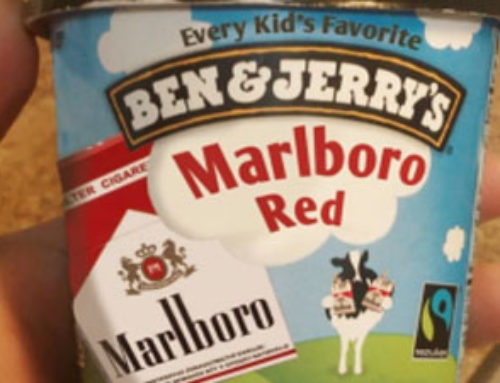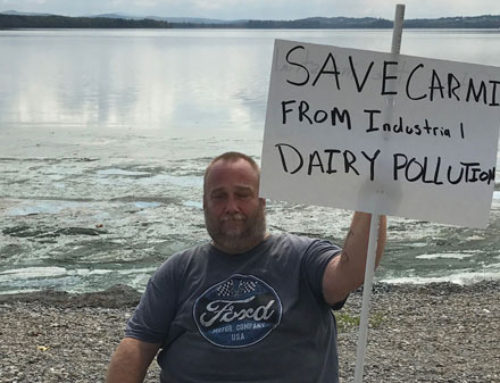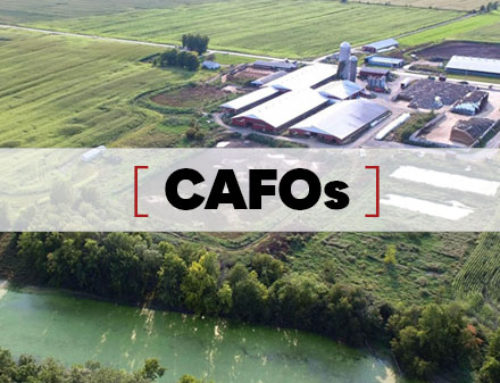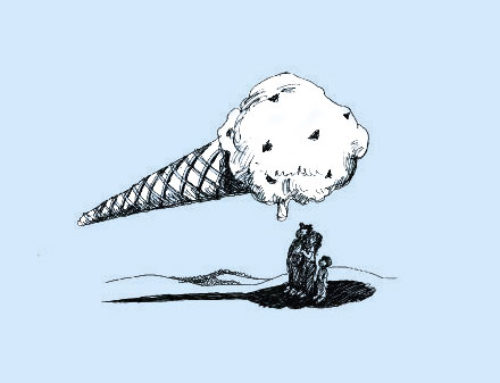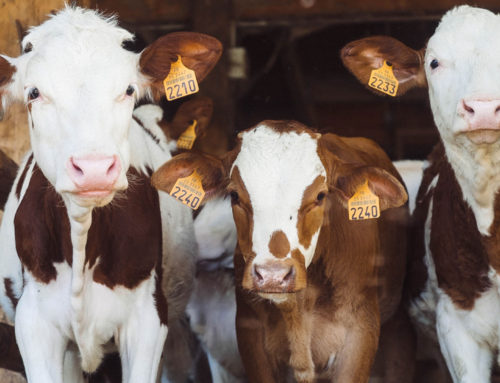By Will Allen and Michael Colby
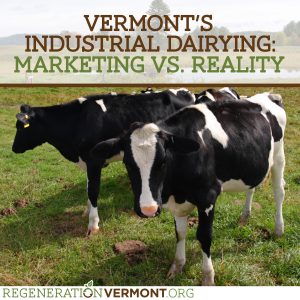 The great divide between the well-marketed image of Vermont dairy farming and its stark and toxic realities is becoming harder and harder to ignore. The marketing shows healthy cows grazing on lush pastures. But the reality is cows on concrete, being fed a diet of GMO-corn and the toxic residues from the hundreds of thousands of pounds of herbicides sprayed annually on the corn and hay fields.
The great divide between the well-marketed image of Vermont dairy farming and its stark and toxic realities is becoming harder and harder to ignore. The marketing shows healthy cows grazing on lush pastures. But the reality is cows on concrete, being fed a diet of GMO-corn and the toxic residues from the hundreds of thousands of pounds of herbicides sprayed annually on the corn and hay fields.
Instead of addressing the toxic legacy of the very non-organic dairying that dominates our agriculture, Vermont’s two giant dairy corporations, Cabot Creamery and Ben & Jerry’s, and the state’s agricultural agency that acts more as their protector than regulator, continue to hide behind the myth and the marketing. It’s a head-in-the-sand approach that is bankrupting farmers, poisoning our rivers and lakes, accelerating climate change, and producing dairy products that may contain those same toxic residues that are so abundantly fed to the cows.
Vermont can do better, much better. And it has to start with addressing the cold, hard facts. Thankfully, Vermont farmers are required to report their pesticide, herbicide and fertilizer usage every year to the state’s Agency of Agriculture, Food and Markets (AAFM). And while some in the Agency and within the agricultural community still try to spin the numbers to keep the myths alive, the reality can’t be ignored: Vermont is farming with more and more toxic chemicals.
From 1999 to 2012, according to AAFM data, Vermont’s dairy farmers applied more than 2,533,329 pounds of metolachlor, atrazine, and simazine to their cornfields. All three of these chemicals are probable human carcinogens, birth defect progenitors, endocrine disruptors, and persistent water polluters. So, at a time when numerous Lake Champlain beaches are being closed because of dairy farm pollution from phosphorous and nitrogen, these toxic chemicals are being used more aggressively, thus contributing to the threatening mix that dominates the northern part of the lake and many of our other waterways.
Both atrazine and simazine have been banned in the European Union (EU), and metolachlor is currently under review by the European Commission. In 2012, twelve U.S. states sued Syngenta, the maker of atrazine, for polluting their drinking water, and won. Vermont regulators, however, failed to join the suit and Vermont dairy farmers continued using atrazine and even larger amounts of metolachlor, further polluting our streams, ponds, rivers, and our precious jewel of a lake. These two corporate chemicals, along with three other popularly used herbicides (simazine, Roundup, and pendimethalin) accounted for more than 99% of the total pesticide use on Vermont corn in 2012.
The U.S. Environmental Protection Agency (EPA) just finished a scathing analysis of atrazine [https://www.epa.gov/ingredients-used-pesticide-products/atrazine-background-and-updates], which found that it could not be used safely, even at much lower concentrations. The EPA findings compared simazine with atrazine and determined that simazine and its breakdown products were as dangerously toxic as atrazine. And yet, as I write on this summer day in Vermont, these chemicals are being widely used on our 92,000 acres of feed corn.
When forced to address the chemical soup applied to our farm fields every year, Vermont’s Agency of Agriculture plays a dangerous shell game, proclaiming to be “mitigating the damages” from herbicides used by dairy farmers. However, when we analyzed the Agency’s own data from 1999-2012, it became clear that what they call “mitagating” is really just substituting one toxin for another.
The Agency, for example, likes to point to the state’s “mitigation” of the use of atrazine. From 1999-2012, the use of atrazine statewide averaged 69,808 pounds per year with a high in 1999 of 98,367 pounds and 85,083 pounds used in 2012. But while the state spotlights the slight decreases in atrazine use, they ignore the dramatic increased use of its toxic relative, metolachlor. Sorry, that’s not mitigation, it’s replacing one toxin for another.
Again, the facts: atrazine, metolachlor, and mesotrione are combined in a mixture called Lumax, with atrazine and metolachlor dominating the mixture. Metolachlor, like atrazine, is an herbicide that is used to kill many of the broadleaf and grass weeds that impact corn and soybean fields.
The average use of metolachlor from 1999-2007 was 61,276 pounds. The average from 2008-12 was 157,192 pounds. What was mitigated when this terribly toxic herbicide more than doubled (2.56 fold) after 2007? Why did the percentage of metolachlor in Lumax increase so dramatically after 2007? Researchers we consulted concluded that as Vermont’s weeds developed a resistance to the herbicide atrazine, more metolachlor was added to the mixture and less atrazine.
What residues of these chemicals remain in our food or persist in our water supply? If the Vermont regulators know, they are certainly not telling the consumers. The Vermont Agency of Agriculture continues to put more emphasis in protecting the corporations who sell these chemicals than protecting our food supply, our markets, and/or consumers. And their protectionism and promotion of confined dairies hurts farmers and belittles Vermont’s brand.
Vermont’s brand is based on the bucolic nature of Vermont’s endless pastures with dairy cows grazing the meadows and hillsides. That imagery no longer reflects reality. Most of the cows are locked up 24/7 in loafing sheds with concrete floors and fed corn, soy, and grass with residues of these poisonous herbicides and insecticides.
Regeneration Vermont is in the process of trying to wake up consumers, the corporate dairy suppliers, and the regulators that these dangerous toxins are probably in our milk, ice cream, cheese, butter, and yogurt, and are definitely in our drinking and recreational waters. We believe that, in order to truly protect the Vermont brand by putting some reality behind it, an immediate transition to regenerative organic dairying needs to be fast-tracked.
This necessary transition is already underway, as more than 200 of Vermont’s remaining 870 dairy farms have already switched to organic, thus shunning the toxic chemicals, avoiding the synthetic nitrogen and phosphorous fertilizers that are causing the algae blooms in the lakes and rivers, and refusing to plant the chemical-needy GMO corn.
Now that’s a brand we can be proud of.
Will Allen and Michael Colby are co-founders of Regeneration Vermont
